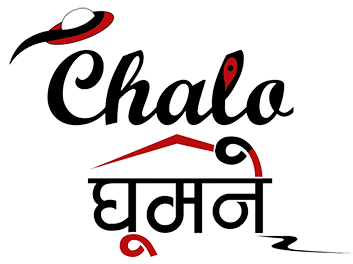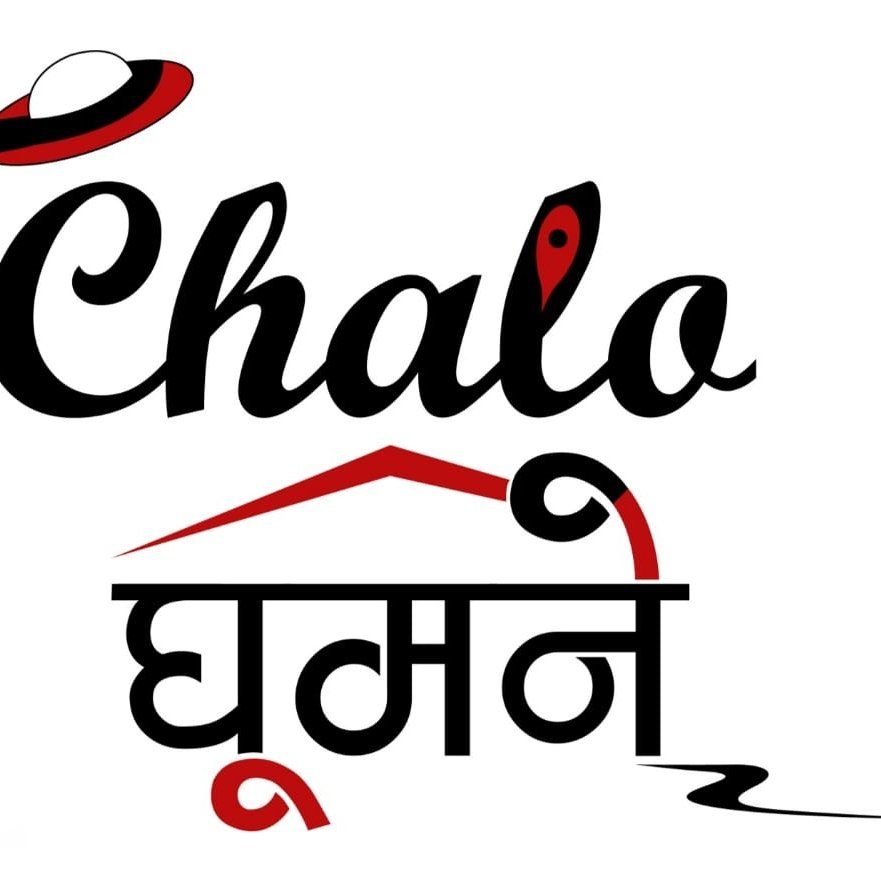The Valley of Flowers & Hemkund Sahib
Facts:
- Distance from Bangalore: 48hrs (2,637.0 km approx) via NH-44
- Terrain: Greenery
- Type: Sub-Alpine
- Total Trek/Hike Kms: 38kms
- Forest Type: Sub-Alpine Forest
- Difficulty Level: Easy to Moderate
- Elevation: 14,400ft
How to Reach the Valley of Flowers?
Bangalore to Dehradun Flight – https://www.goibibo.com/flights/bangalore-to-dehradun-flights/
Dehradun to Rishikesh Bus: https://www.yatra.com/bus-tickets/dehradun-to-rishikesh
Dehradun to Rishikesh Train:
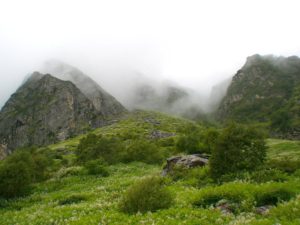
Rishikesh to Govindghat: You need to travel to Govindghat which lies on the Rishikesh-Badrinath highways about 25 km before Badrinath and almost 272 km away from Rishikesh. 272 km in the winding Himalayan roads means that it is going to be a long road drive to get to Govindghat. Traveling on your own: If you are traveling with 4-5 people it makes sense to hire your vehicle which will cost about Rs 6,000 – Rs 6,500. If you are traveling alone or just want a cheaper option, you can take the Rishikesh Badrinath bus and get off at Govindghat.
The bus to Badrinath leaves the Rishikesh bus stand at 4 am. You can also take the bus to Pandukeshwar which leaves Rishikesh at 4.30 am. The bus fare is around Rs 400. In case you miss these early buses, do not worry, you can take buses to Joshimath which leave Rishikesh at 6 am. Joshimath is 20 km before Govindghat and also takes 10-11 hours to reach. Stay over at Joshimath for the night and take a shared cab (Rs 50 per head) to Govindghat the next morning from the Badrinath taxi stand. You can then skip the stay at Govindghat and get on the trek directly.
You can trek from Govindghat to the Valley of Flowers as it is very near to Govindghat.
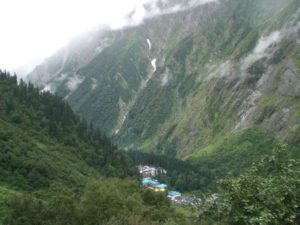
About the Place: Valley of Flowers is situated in North Chamoli and Pithoragarh in Uttarakhand. This valley is nestled in the upper plains of Bhyundar Ganga near Joshimath in the Garhwal region. The lower reaches of Bhyundar Ganga near Govindghat are known as Bhyundar Valley. The Valley of Flowers is in the Pushpawati valley 23 km north-northwest of Nanda Devi Park.
Well-known for its lush green meadows of endemic alpine flowers, and variety of different other floras, this richly divergent area is also a dwelling place for rare and endangered animals, including the Asiatic black bear, snow leopard, musk deer, brown bear, red fox, and blue sheep. Birds found in the park include Himalayan monal pheasant and other high altitude birds.
The Valley of Flowers is a high-altitude Himalayan valley that has long been acknowledged by famous mountaineers, botanists, and literature experts. It has been recognized internationally for over a century and is referred to in the Hindu religion. Local people have paid a visit to the valley since ancient times. Indian yogis are known to have meditated on this valley. There are hundreds of different colorful flowers, with various shades of colors in this valley.
The valley was declared a national park in 1982. In 2002, it was proclaimed as a World Heritage Site and has gained importance as a region containing, a range of alpine flora, representative of the Western Himalayan alpine shrub and meadows of the ecoregion. \
The place was little known to the outside world due to its inaccessibility.
In 1931, Frank S. Smythe, Eric Shipton, and R.L. Holdsworth, all British mountaineers, lost their way while returning from a successful expedition to Mt.Kamet and happened upon the valley, which was full of flowers. They were attracted to the beauty of the area and named it the “Valley of Flowers.” Frank Smythe later authored a book of the same name.
Trek to the Valley of Flowers
The Valley of Flowers trek is one of the most mesmerizing and famed treks in the Himalayas of the Uttarakhand State. The difficulty level to scale this mountain is moderate. As the mountain is steep, it is a bit challenging to ascend. So, it is not recommended for beginners or inexperienced trekkers. This magnificent valley is like a carpet of multicolored flowers on the entire mountain. A narrow path in between the flowers entices you to go deeper. You come across flowers of not only different colors but also in various shapes, sizes, textures, and fragrances.

The cool mountain breeze coming from the glacial end of the valley brings with it some wonderful fragrances that you would have never known before. The climb to the Hemkund lake is a bit difficult. In 6 km you would have ascended almost 4,000 ft. This not only introduces a new challenge, but it also takes you to a breathtaking zone. A bird’s eye view of the landscapes around is very captivating.
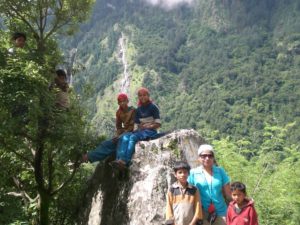
The higher you scale, the more precipitous it will be. As you climb further, you will reach alpine cliffs. The scenery up there is truly a bliss amidst the blowing thin air. Once you reach the pristine pure Hemkund lake, you will be stunned by the enchanting views in the surrounding. You will come across several youngsters, middle-aged, elderly, children, and toddlers embarking on this incredible trekking adventure to have a glimpse of the lake at a height of 14,000 ft. above. Many travel on ponies or even take help from the porters.
However, quite a few of them climb on their might.
It is very inspiring to watch the volunteers sweeping every nook and corner of the trail, to keep it clean, and at the same time, they even work at Hemkund Sahib Gurdwara in freezing temperatures. Though the valley is very picturesque, you cannot camp here as it is a very ecologically sensitive area. Nobody is allowed to stay overnight.
Best time to visit the Valley of Flowers: You can visit during June as the gates of the Valley of Flowers opens at the beginning of this month. However, an ideal time to visit is from July until the end of September.
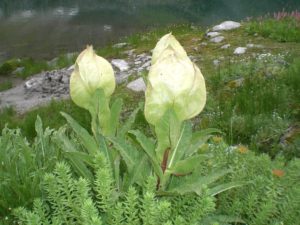
Here is a brief description of how nature unfolds itself during July, August, and September in the Valley of Flowers.
- JULY: July is a fantastic month to visit as you will witness lush green foliages almost everywhere you see. With the first bloom of the flowers, the peak flowering season begins after mid-July. You will come across a few geriatric snow bridges and some melting snow patches. The valley is least crowded during July, and you can also expect a drizzle of rain.
- AUGUST: During the first 15-days of August, you will come across a vast variety of flowers amidst the cool showers of rain. The valley will be crowded on the weekends, so it’s recommended to visit during weekdays. Tip: Watch out for the precious Brahma Kamal as you climb to Hemkund Sahib. This beautiful flower only grows around the altitude of 14,000 feet so it is a rare sighting there.
- SEPTEMBER: The flowers would have withered by now, and the valley would be overcrowded with pilgrims who visit Gurudwara of Hemkund Sahib during September. At the time of the peak monsoon, make it a point to visit the Valley of Flowers in the first half of the day and be back by 2 pm. Post that, the intensity of the rain increases, making it risky to cross the fragile bridges over the Lakshman Ganga river.
The temperature on the Valley of Flowers:

It is not extremely cold on the Valley of Flowers and Hemkund Sahib trek as trekkers trek in the post-summer months of July, August, and early September. Official Monsoon season in Uttarakhand starts by the second week in July. Be prepared beforehand taking along the raincoat and rain pants with you. Nevertheless, until the first half of July, there won’t be much rain. It will be a gladdening experience to trek amid the drizzling rain.
On the trail to Hemkund, you get a handful of snow patches to cross early in the season. Expect to see melting snow flowing into Hemkund Sahib early in July. Most of the snow is gone once the rainy season sets in by August.
Orchids of the Valley of flowers:

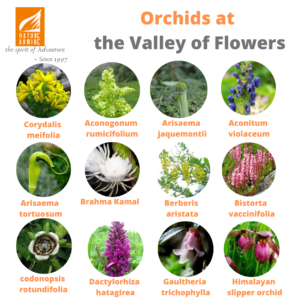
How difficult is the Valley of Flowers Trek?

You need to trek along 38kms, covering the entire distance in four days. Every day you will be scaling an altitude of approximately 2000ft, and on some days even more. Hence, for your body to handle this trekking distance and increasing altitudes, you need to have good fitness levels.
Tip: Before the trek begins, you should be able to comfortably run 5 km in under 40 minutes.
To make it easier for you to trek without any hassles, here is a list of difficult and tricky sections you will come across on the Valley of Flowers Trek:
- Rockfall area in the valley: There are two rockfall sections on this trek. You will witness the first one between Govindghat to Ghangria on the first day, and the second one lies around 20 minutes from the forest checkpoint, as you trek from Ghangria to Valley of Flowers. Safety Advice: Be quicK and cross the bridge without stopping, in one go. Both rockfall sections on the Valley Of Flowers trek are only about 20 meters long. Be mentally prepared for these and stay alert
- The melting snow blocks on the way to Hemkund Sahib in July and August: Though there won’t be any snow on the trails, you get snow melts falling from the mountainous region above the trails. Be cautious and keep an eye open especially on the mountainous region while ascending uphill to Hemkund. Safety Advice: If you are feeling unsure, ask for guidance. Your guide usually puts stones to step upon without getting your feet wet
- The hard climb to Hemkund Sahib and altitude sickness: Symptoms of Acute Motion Sickness or (AMS) like headache, dizziness, and nausea are the most common side-effects while climbing to Hemkund Sahib. Mounting almost 4000 ft from 9,600 ft to 14,100 ft in a single day is the major reason behind you feeling these symptoms. So trek up slowly, taking breaks after every 100mts taking deep breaths. Safety Advice: If you get any symptoms of AMS, immediately alert your guide, to get timely treatment to help your body acclimatize slowly to the increasing altitude.
- Bridge over rivers: There are a couple of bridges on the Lakshman Ganga river on the way to Govindghat to Gangria and a bridge over Pushpavathi from Gangria to Valley of Flowers. The bridge is narrow on the trails. Be careful of mule trains crossing over the bridges, do not get stuck with them. Be meticulous about the water levels below the bridge. Do not crowd on the bridge. Safety advice: Walk always on the side nearer to the mountain, primarily because of mules.
- Hard snow crossing en route to the Valley of flower: Early in the season, when you are on the way to the valley of flowers, you will come across a patch of hard-snow extending over the trail to the Pushpavati river. It is a short 10-meter patch nevertheless, you need to negotiate it with firm footing. A trekking pole and your trekking shoe come in handy to put firm footings in the snow. If you do not have a trekking pole, make patches on the hard snow with your shoe to get a firm footing. Safety advice: If you are feeling too nervous on the hard snow crossing, request your guide to help you out by showing the steps or holding your hand through it.
Safety on the Valley of Flowers – Terrain Wise
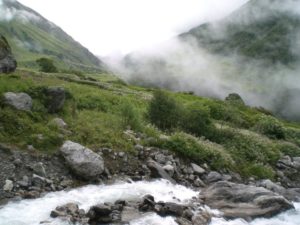
When it comes to terrain, the Valley of Flowers can be considered a safe place to trek.
- The entire route is well-marked
- Well trodden routes
- Most ascents are gradual except the climb to Hemkund Sahib.
- Well placed campsites (important when considering AMS)
- Easy exit points
There are hardly any areas that are challenging and require technical assistance. The only difficult segment is the climb to Hemkund Sahib. However, even this segment does not require technical assistance.
Safety of Valley of Flowers – Altitude Wise
Stay alert if you get any symptoms of AMS, and immediately inform your guides. You will be at high-risk of AMS while trekking from Gangria to the Valley of Flowers. Check oxygen levels at regular intervals, go on a curative course of Diamox, drink water, and rest. If you do not feel normal after a few hours or overnight, do not proceed further on the trek.
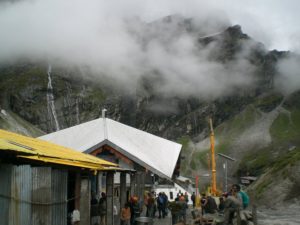
Exit points on Valley of Flowers trek
Valley of Flowers, being a pilgrims trail, is well laid out and has easy exits from Ghangaria. The nearest hospital in case of a medical emergency is the army hospital at Joshimath. It is around an hour’s drive from Govindghat.
Mandatory Documents to carry On Valley Of Flowers Trek
Carry an original and photocopy of the government photo identity card. Anything such as a driver’s license, Aadhar card, a passport will do. You will need to submit your identification to the forest department. Without these, you will not be allowed to trek.
Tip: Keep important documents in a clear plastic cover and slide them into the inner pocket at the back of your backpack to prevent them from getting wet.
Sample Itinerary:
- Day 01 – Haridwar/ Rishikesh/Dehradhun drive to Joshimath – Overnight stay here.
- Day 02 – Drive down to Govindghat, from here you will start your trek to the Valley of flowers, at the base there is a Gurudwara, cross the bridge on the Alakananda river and continue your trek for the day to the basecamp at Ghangria.
- Day 03– Ghangria to The Valley of Flowers Sanctuary.
- Day 04 – Ghagria to Hemkund Sahib
- Day 05 – Ghangria to Govindghat, if weather is perfect then hit to Badrinath – Night halth here.
- Day 06– Visit Badrinath, if you get permission then travel to Mana village or visit Vasundhara waterfalls.
- Day 07– Have a backup for a day.
- Day 08- Drive back to Rishikesh/Haridwar/Dehradhun (Very tiring and a long journey).
Note: The itinerary is subject to change depending upon the weather conditions and the landslides considering the monsoons in July, August, September.
Place To Visit Around Valley Of Flowers
- Badrinath Temple: An abode of Lord Vishnu, this pilgrimage will be almost empty during July. You can spend more than an hour in the temple premises having the good darshan of the Lord, and also witness the aarti without any disturbance. Usually, when there’s a crowd, you can hardly stand there even for a minute
